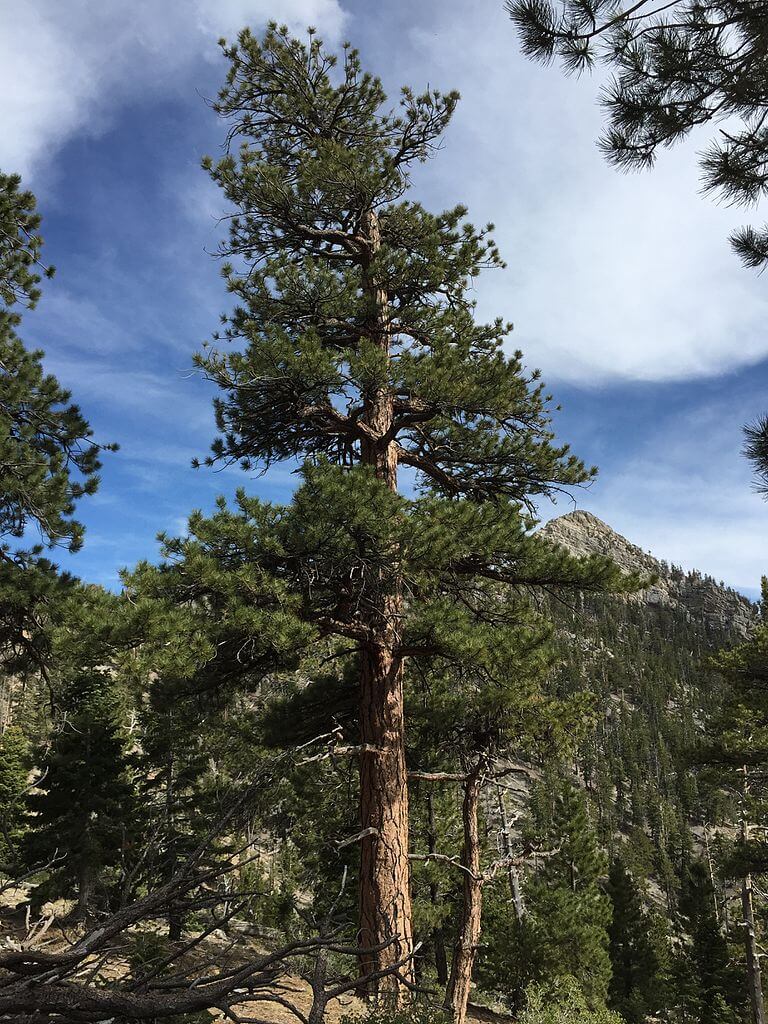Ponderosa Pine
by Terry Habeger
Broadcast 9.14 & 9.17.2021

Ponderosa pine, Montana’s state tree. Photo by Famartin, CC-by-SA 4.0.
Listen:
My love affair with the ponderosa pine started with trips through the forest, on my way to the south rim of the Grand Canyon. It continued with hiking and biking trips through Pattee Canyon, a short way from Missoula, Montana. Their height and orange-brown bark, scaly and large-patterned, drew me to them, but I knew little else about them.
The name, for example, where did that come from? One theory is that the Spanish Conquistador, Coronado, in the 1500s, saw the tree as ponderous because of its size and heavy wood. Settlers brought that name north and it became ponderosa.
These heaven-bound trees became the state tree of Montana! They have a straight trunk, towering 200 feet or more. Their canopy is 25 to 30 feet wide. They need lots of sun and seem to take most of it from anything of size below them. I enjoy the open view between the trees when I hike in Pattee Canyon. Maybe the contentment I feel is linked to the sweet turpentine-like aroma the trees give off.
I was surprised to learn how these trees reproduce! It begins after their seventh year and can continue until they are 350 years old. They are monoecious, which means that each tree has female and male cones. The male cones appear only in spring and are found near the bottom of the tree. The female cones appear higher up. This placement of the cones may prevent pollination of the female from the male of the same tree, ensuring better genetic diversity. Truly a wonder of nature, I am thinking! The male cones produce lots of pollen. When released it is hopefully wind-blown to other trees. The male cone, like some insects and mammals after mating, dies and disappears after releasing its pollen. Once pollinated, the female cone takes up to two years to produce seeds, which form at the base of each scale on the cone.

The author with his wife and grandsons at the Grandfather Tree in Pattee Canyon, Missoula. Photo courtesy Terry Habeger.
I am here because my grandsons from Missoula want to show me a special ponderosa, the Grandfather Tree! It is located in Pattee Canyon and perhaps known only to locals. The trunk size is approximately 5 feet in diameter, with low, moss-covered branches. I stand under the tree with my grandsons, reflecting for a moment on what lies ahead for me and these young boys. It feels good to know that future generations will benefit from the ponderosa forest’s ability to absorb a great deal of carbon from the atmosphere.
My years of enjoying the ponderosa are relatively short compared to their lifespan of 300 to 600 years. I think their prominence in the West shows how well they have adapted. Their thick bark makes them highly fire resistant. The wide spreading root system, with a deep taproot, helps them survive drought and windy conditions, and makes them useful as erosion control and wind breaks. Native Americans, possibly the Salish or Kalispel tribes in western Montana, ground the inner bark into flour, and in early spring the bark scrapings yielded a sweet treat. A tea was made with the needles, and the inner bark gum became a medicine.
I am glad they are still here! It’s fall in Pattee Canyon, and I am hiking with my grandsons and family. On the path I see the ponderosa’s female reddish brown cones. The cones are typically three to six inches long, with each scale tipped with a sharp prickle. If I were to try growing a tree in Wisconsin, I would gather some of these cones. Their hard brown seeds will separate from the cone when dried.
On my next trip to Missoula, I will gather some needles for tea, and my two grandsons and I will once again touch the bark of the Grandfather Tree!
Every week since 1991, Field Notes has inquired about Montana’s natural history. Field Notes are written by naturalists, students, and listeners about the puzzle-tree bark, eagle talons, woolly aphids, and giant puffballs of Western, Central and Southwestern Montana and aired weekly on Montana Public Radio.
Click here to read and listen to more Field Notes. Field Notes is available as a podcast! Subscribe on iTunes, Google Play, or wherever you listen to podcasts.
Interested in writing a Field Note? Contact Allison De Jong, Field Notes editor, at adejong [at] montananaturalist [dot] org or 406.327.0405.
Want to learn more about our programs as well as fun natural history facts and seasonal phenology? Sign up for our e-newsletter! You can also become a member and get discounts on our programs as well as free reciprocal admission to 300+ science centers in North America!












